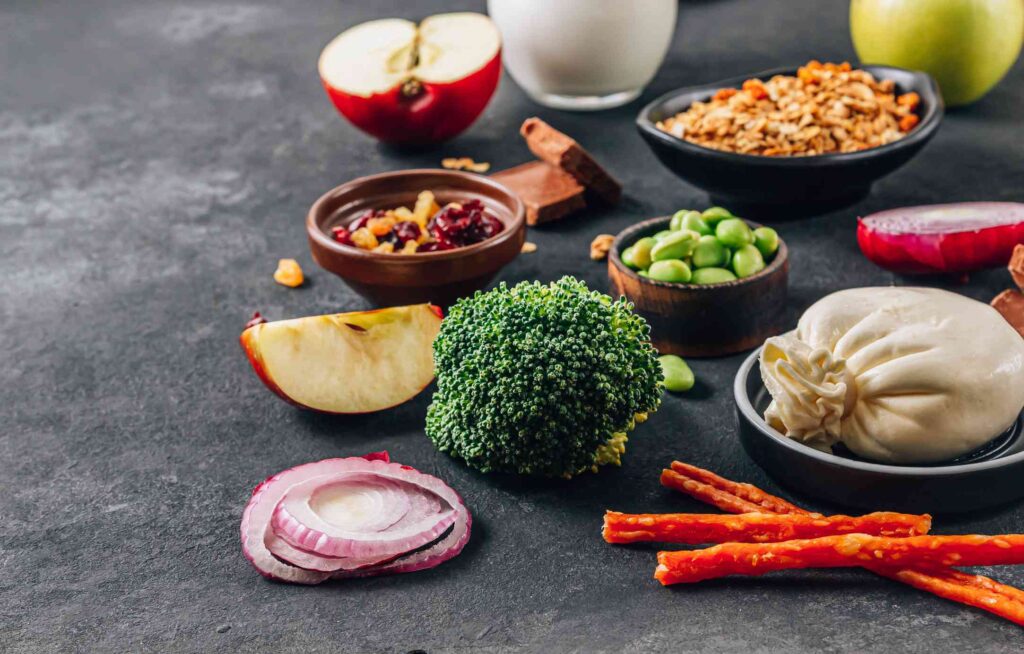:max_bytes(150000):strip_icc():format(jpeg)/Health-GettyImages-1357953042-f3c7ede3783a4599aeed2503031be83c.jpg)
If you have irritable bowel syndrome (IBS), your healthcare provider may suggest swapping high-FODMAP foods for a low-FODMAP diet. FODMAPs (fermentable oligosaccharides, disaccharides, monosaccharides, and polyols) are carbohydrates that aren’t fully digested in the intestines.
As they move through the small intestine, FODMAPs pull in water. When they reach the large intestine, gut bacteria break them down, producing gas. This extra water and gas causes the intestine to stretch, leading to pain and discomfort for people with IBS, who have more sensitive digestive systems.
For this reason, people with IBS may benefit from limiting high-FODMAP foods (foods rich in FODMAP carbohydrates) and prioritizing low-FODMAP foods instead.
The low-FODMAP diet is made for people with IBS. It may not be effective for other conditions, like celiac disease, inflammatory bowel disease, or bowel cancer, which can have similar symptoms.
Apples are a popular fruit that’s portable and hardy. They also contain polyols, the “P” in FODMAPS. Polyols are sugar alcohols naturally found in some fruits, vegetables, and sugar-free sweeteners.
Polyols can cause intestinal dysmotility in people with IBS. This means the digestive system doesn’t move food through the intestines properly, which can lead to problems like gas, stomach discomfort, and laxative effects. The more polyols you eat, the worse these symptoms can get.
Used in many recipes, onions are known for their strong taste and aroma. There are various types, including yellow, red, sweet, white, scallions, and shallots.
Onions contain fructans, which are oligo- or polysaccharides made up of short chains of fructose molecules with a glucose molecule at the end.
The body can only digest a small amount of fructans because it lacks the enzymes needed to break them down fully. Most fructans pass through the small intestine to the large intestine, or colon, where gut bacteria ferment them. Fructans also pull water into the intestines, which can lead to bloating and diarrhea.
Known for its pungent taste and odor, garlic is a popular ingredient in many cuisines. Like onions, it contains fructans.
According to the researchers who developed the low-FODMAP diet, some people with IBS may react to garlic but not other fructan sources. Completing food trials with different high-fructan foods can help you identify which ones cause reactions and in what amounts.
Wheat, the main ingredient in many breads, pastas, cereals, and baked goods, also contains fructans. There are different types of wheat, such as wheatberries, durum, and emmer.
Unlike garlic and onions, wheat contains gluten, a protein that people with celiac disease or gluten sensitivity need to avoid. This is important because digestive issues like diarrhea, constipation, and abdominal pain can occur in both IBS and gluten-related conditions.
It’s always best to consult your healthcare provider before making any major dietary changes.
Many people drink milk to get calcium and other nutrients. Even if you don’t drink cow’s milk, you may consume some milk products like cheese or yogurt.
Milk contains lactose, a disaccharide and the “D” in FODMAPs. Other high-FODMAP milk products include soft cheeses like ricotta, cottage cheese, and cream cheese, as well as butter, cream, ice cream, and yogurt.
Lactose intolerance can cause digestive symptoms like bloating, diarrhea, and gas because the small intestine cannot fully digest lactose. Different people can tolerate varying amounts of lactose before experiencing symptoms.
The symptoms of lactose intolerance can be hard to tell apart from those of IBS. Lactose intolerance symptoms only occur after consuming lactose-containing products. Make sure to consult your healthcare provider for an accurate diagnosis.
Legumes, including beans, peas, and lentils, are enjoyed in many dishes, from tacos and soups to salads and chilis. They contain galactans, a type of oligosaccharide and the “O” in FODMAPs.
This group is known as galacto-oligosaccharides (GOS). These are chains of galactose sugars with a glucose molecule at the end. Like fructans, GOS supports beneficial bacteria in the gut and can produce some gas, a normal part of digestion.
Since humans lack the enzymes needed to break down the bonds between galactose sugars, GOS passes through the gut undigested. For people with IBS and a hypersensitive gut, this poor absorption can lead to digestive symptoms like bloating, abdominal discomfort, and altered gut motility.
The high-FODMAP foods listed above are among the most commonly consumed, but there are many others. Keep in mind this is not an exhaustive list:
Fructans
- Barley
- Brussels sprouts
- Cabbage
- Broccoli
- Artichoke
- Pistachio
- Inulin or chicory root
Galactans
- Soy milk
- Soy protein isolate
- Veggie burgers
- Coffee (more than one cup per day)
Polyols
A low-FODMAP diet is typically followed short-term to identify triggers. Once symptoms improve, you may be able to reintroduce high-FODMAP foods gradually to see what you can tolerate. The diet is best done under the guidance of a medical doctor and registered dietitian trained in this approach.
When cutting back on high-FODMAP foods, try incorporating these low-FODMAP options:
- Fruits: Cantaloupe, kiwi, mandarin, orange, pineapple, and strawberries
- Vegetables: Carrots, celery, lettuce, spinach, and turnips
- Protein sources: Firm tofu, tempeh, eggs, and plain cooked meat, poultry, and seafood
- Grains and starches: Rice, oats, quinoa, and potatoes
- Dairy and milk alternatives: Lactose-free dairy milk and almond milk
- Cheese: Hard cheeses such as cheddar, Swiss, and parmesan
Be aware that some marinades, sauces, and other condiments may contain FODMAPs.
A research review of 13 clinical trials with 944 patients found that a low-FODMAP diet was the most effective diet for improving IBS symptoms compared to other diets. It ranked highest for reducing symptoms like abdominal pain and bloating against other standard dietary advice from medical institutions.
Another review found that multiple clinical trials show a low-FODMAP diet can effectively manage IBS. This diet is especially helpful in reducing bloating. Around 50–75% of patients experience improvement with this approach.
Other research shows that IBS symptoms improve for 3 out of 4 people on a low-FODMAP diet. This diet helps reduce pain, bloating, and discomfort, improves bowel habits like diarrhea or constipation, and boosts overall quality of life.
For individuals with IBS, following a low-FODMAP diet can help identify trigger foods. Common high-FODMAP foods include apples, onions, garlic, wheat, milk, and legumes. Many other foods are also high in FODMAPs.
Since many common foods contain FODMAPs, it’s essential to ensure you’re still getting the nutrients you need by incorporating low-FODMAP alternatives.
This diet is specifically designed for IBS, so it’s best to start with a proper diagnosis and follow a treatment plan with guidance from a healthcare provider experienced in FODMAPs. While it requires careful planning, the low-FODMAP diet has shown positive results in easing IBS symptoms and improving quality of life.













